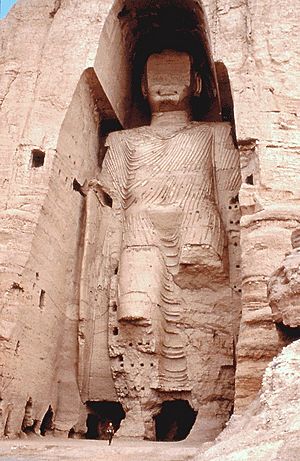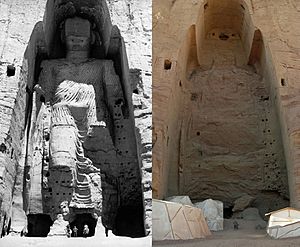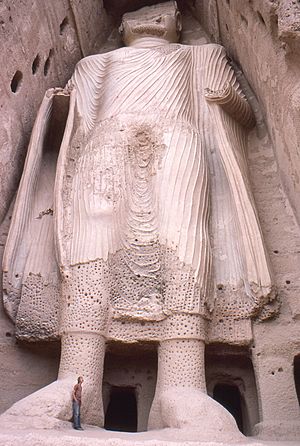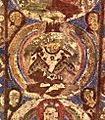Buddhas of Bamiyan facts for kids
| UNESCO World Heritage Site | |
|---|---|

Taller Buddha of Bamyan before 2001
|
|
| Location | Bamyan, Afghanistan |
| Part of | Cultural Landscape and Archaeological Remains of the Bamyan Valley |
| Criteria | Cultural: i, ii, iii, iv, vi. |
| Inscription | 2003 (27th Session) |
| Endangered | 2003-present |
| Area | 105 ha |
| Buffer zone | 225.25 ha |
The Buddhas of Bamiyan (Persian: بتهای باميان – but hay-e bamiyan) were two giant statues of Buddha. They were carved into the side of a cliff in the 6th century. These amazing statues were located in the Bamyan valley in central Afghanistan.
Sadly, the statues were destroyed in March 2001 by a group called the Taliban. Countries like Japan and Switzerland have offered to help rebuild these important historical artworks.
Contents
What Were the Buddhas of Bamiyan?
The Buddhas of Bamiyan were two very large statues. They were carved directly into a sandstone cliff. One statue was about 55 meters (180 feet) tall. The other was about 38 meters (125 feet) tall. They showed Buddha standing upright.
These statues were a big part of the ancient Buddhist culture in the region. They were built a long, long time ago, around the 6th century. The Bamiyan valley was an important stop on the Silk Road. This was a famous trade route connecting the East and West. Many travelers and traders passed through here.
Why Were They Important?
The Buddhas of Bamiyan were more than just big statues. They were important pieces of art and history. They showed how different cultures mixed in this area. The statues were a blend of Indian, Greek, and Central Asian art styles. This style is called Gandharan art.
The cliff face around the statues also had many caves. These caves were homes for monks and places for worship. Some caves had beautiful paintings on their walls. These paintings told stories and showed religious scenes. The whole area was a UNESCO World Heritage Site. This means it was recognized as very important to the world's history and culture.
The Destruction of the Buddhas
In March 2001, the Taliban decided to destroy the Buddhas. They used dynamite to blow up the statues. This act caused a lot of sadness around the world. Many people saw it as a loss of global heritage.
The Taliban believed that the statues were idols. Their beliefs led them to destroy these ancient works of art. This event highlighted the dangers faced by historical sites during conflicts.
Efforts to Rebuild and Remember
After the destruction, there was a lot of discussion about what to do. Some people wanted to rebuild the statues. Others thought it was better to preserve the site as it was. They wanted it to be a reminder of what happened.
Today, the empty niches where the Buddhas once stood are still there. They serve as a powerful symbol. They remind us of the importance of protecting cultural heritage. Many groups are working to preserve the Bamiyan valley. They are also trying to protect the remaining caves and paintings.
Images for kids
-
The site being destroyed by the Taliban.
-
An engraving of the Buddhas, as seen by Alexander Burnes in 1832.
See also
 In Spanish: Budas de Bāmiyān para niños
In Spanish: Budas de Bāmiyān para niños





























